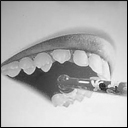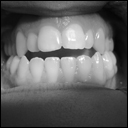Odontopediatrics is the specialty that treats Odontology in children. Questions about our children’s dental health
1 – At what age do baby teeth come out?
he lower central incisors erupt from the age of six months, and until the age of 27 months approximately, when the second upper molars come out.
Orientative calendar:
- 6 months: lower central incisors
- 9 months: upper central incisors
- 11 months: upper lateral incisors
- 13 months: lower lateral incisors
- 15 months: lower first molars
- 16 months: upper first molars
- 20 months: upper and lower canines
- 26 months: lower and upper second molars
2 –When do permanent teeth come out?
There are three eruption periods:
- First period: 6-9 years old
First molars and lower central incisors (from the age of 6 and for about a year). Lower lateral incisors. Upper lateral incisors (around the age of 9).
- Second period: 10-12 years old
Premolars and canines. Second molars (around the age of 12)
- Third period: 15-25 years old
Wisdom teeth or third molars.
3 –From what age is it recommended that you take your children to the dentist?
From the age of 5-6 if they haven’t had any traumatism, baby bottle caries or any other problem.
4 –When must they start using a toothbrush?
From the age of three, but before that, parents must clean their teeth with a cloth before putting them to bed.
5 –How do we teach our children to brush their teeth?
We must explain to them that teeth have to be brushed on every side, massaging the gums, even if they hurt orbleed a little. No time must be spared in brushing our teeth!
6 –How many times per day must we brush our teeth?
 At least three times, but it is important to know that the most important brushing is at night, as we produce saliva while we sleep and are less protected against caries.
At least three times, but it is important to know that the most important brushing is at night, as we produce saliva while we sleep and are less protected against caries.
7 – Must a lip frenulum be removed? When?
It depends on the case. The upper lip frenulum is the most common one and can cause a separation between the two upper incisors. We must wait until the upper canines come out, as they can close that space. If not, it should be closed with a fixed brace and afterwards the frenulum must be removed.
A short lingual frenulum must be cut in order to allow the tongue to move freely and roof the palate, thus avoiding pronunciation problems, morphological jaw problems and dental mispositioning.
The lower lip frenulum, if it has insertions in the gum that covers lower incisors, can cause recession problems on those teeth.
It is important to examine it before starting an orthodontic treatment.
8 –At what age should you start correcting teeth malpositioning?
 Normally from the age of eleven, although in certain cases like crossbites, we must start earlier. For this reason, it is recommended that you go to an orthodontist from the age of seven, in order to have a complete Orthodontic Examination, including X-rays and dental impressions, after which the specialist can tell you if there are any problems, and when, for how long and with which type of brace to solve them.
Normally from the age of eleven, although in certain cases like crossbites, we must start earlier. For this reason, it is recommended that you go to an orthodontist from the age of seven, in order to have a complete Orthodontic Examination, including X-rays and dental impressions, after which the specialist can tell you if there are any problems, and when, for how long and with which type of brace to solve them.
9 –What types of malpositioning can parents detect?
There are some very obvious malpositions, such as teeth crowding and a narrow or high-arched palate, but there are others which are not so clear and can also be detected precociously, like for example:
CROSSBITE
The lower teeth land in front of the upper teeth, when it should be the other way round.
OPEN BITES
The upper teeth do not touch the lower teeth when the mouth closes. Sometimes it is caused by thumb sucking.
OVERBITE
It is to be seen when the upper teeth cover the lower teeth almost completely when the mouth is closed.
10 –Which types of braces are there for children?
REMOVABLE APPLIANCE:
The patient can take it off and it is normally placed in a first phase when the child has its baby teeth and permanent teeth at the same time. These braces have an auxiliary role as preliminary treatments for pre-adolescents, and as retainers for any type of patient.
FUNCTIONAL APPLIANCE:
Serves to modify the growth of the maxillary bones through orthopaedics.
FIXED APPLIANCES:
They are normally used when all or almost all permanent teeth are present: bracket system.











